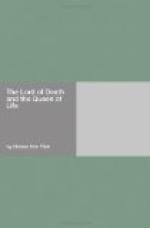They took a great many photos as a matter of course. Also, they investigated some of the big, octagonal machines in the streets, finding them to be similar to the great “tanks” that were used in the war, except that they did not have the characteristic caterpillar tread; their eight faces were so linked together that the entire affair could roll, after a jolting, slab-sided, flopping fashion. Inside were curious engines, and sturdy machines designed to throw the cannon-shells they had seen; no explosive was employed, apparently, but centrifugal force generated in whirling wheels. Apparently these cars, or chariots, were universally used.
The explorers returned to the cube, where they found that Smith, happening to look out a window, had spied a pond not far off. The three visited it and found, on its banks, the first green stuff they had seen; a tiny, flowerless salt grass, very scarce. It bordered a slimy, bluish pool of absolutely still fluid. Nobody would call it water. They took a few samples of it and went back.
And within a few minutes the doctor slid a small glass slide into his microscope, and examined the object with much satisfaction. What he saw was a tiny, gelatinlike globule; among scientists it is known as the amoeba. It is the simplest known form of life—the so-called “single cell.” It had been the first thing to live on that planet, and apparently it was also the last.
V
THE CLOSED DOOR
As they neared Jackson’s pet “mansion” each man paid close attention to the intervening blocks. For the most part these were simply shapeless ruins; heaps of what had once been, perhaps, brick or stone. Once they allowed the cube to rest on the top of one of these mounds; but the sky-car’s great weight merely sank it into the mass. There was nothing under it save that same sandy dust.
Apparently the locality they were approaching had been set aside as a very exclusive residence district for the elite of the country. Possibly it contained the homes of the royalty, assuming that there had been a royalty. At any rate the conspicuous structure Jackson had selected was certainly the home of the most important member of that colony.
When the three, once more in their helmets and suits, stood before the low, broad portico which protected the entrance to that edifice, the first thing they made out was an ornamental frieze running across the face. In the same bold, realistic style as the other sculpture, there was depicted a hand-to-hand battle between two groups of those half savage, half cultured monstrosities. And in the background was shown a glowing orb, obviously the sun.
“See that?” exclaimed the doctor. “The size of that sun, I mean! Compare it with the way old Sol looks now!”
They took a single glance at the great ball of fire over their heads; nine times the size it always seemed at home, it contrasted sharply with the rather small ball shown in the carvings.




